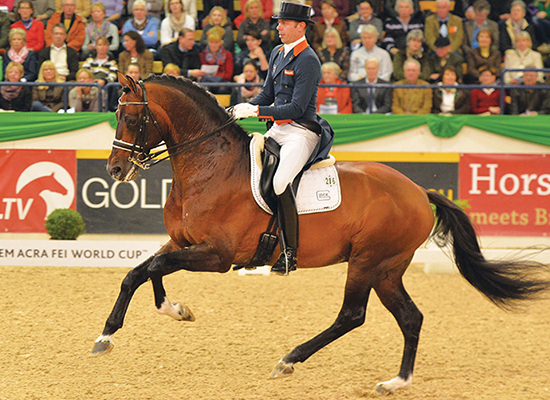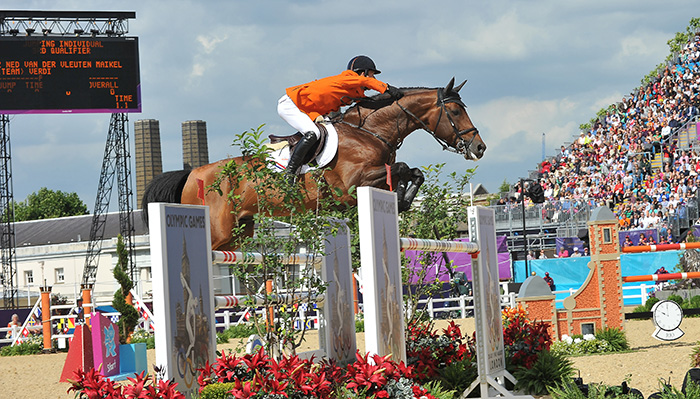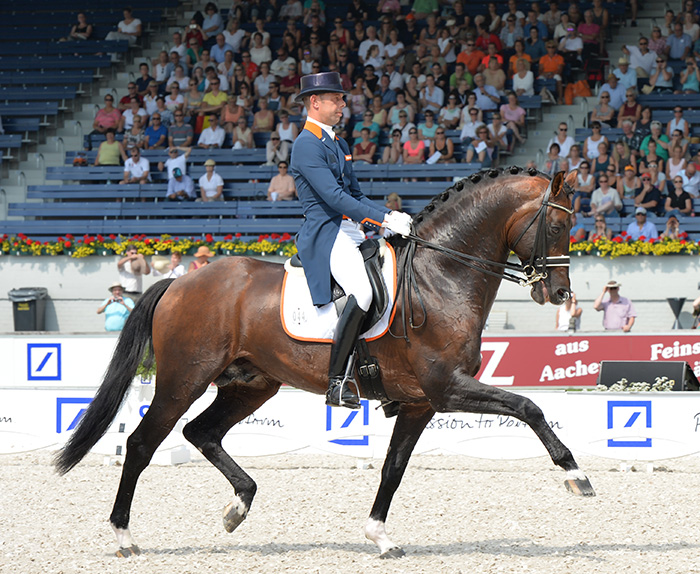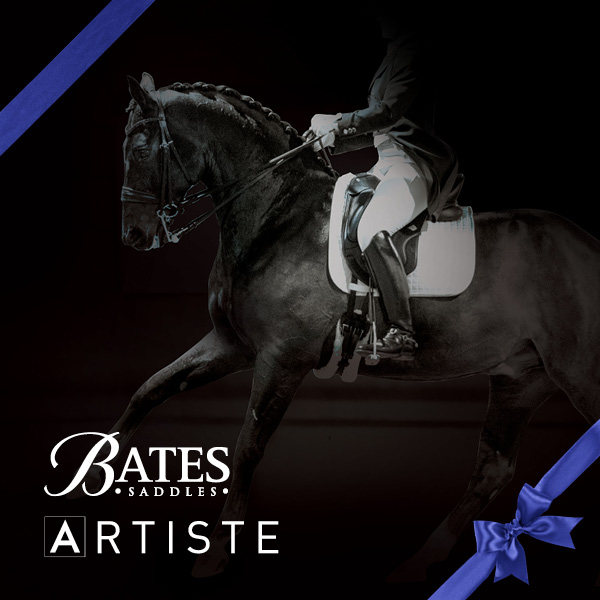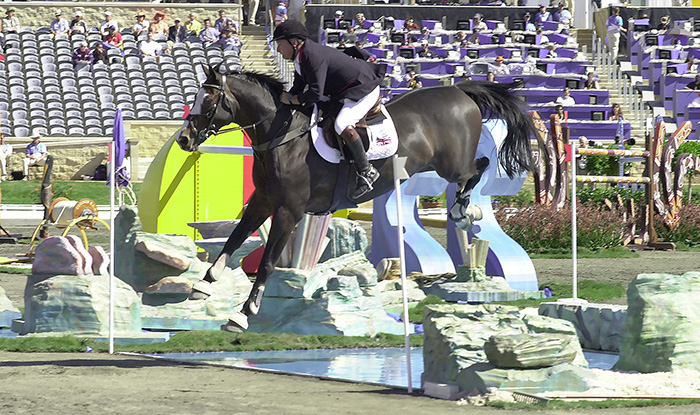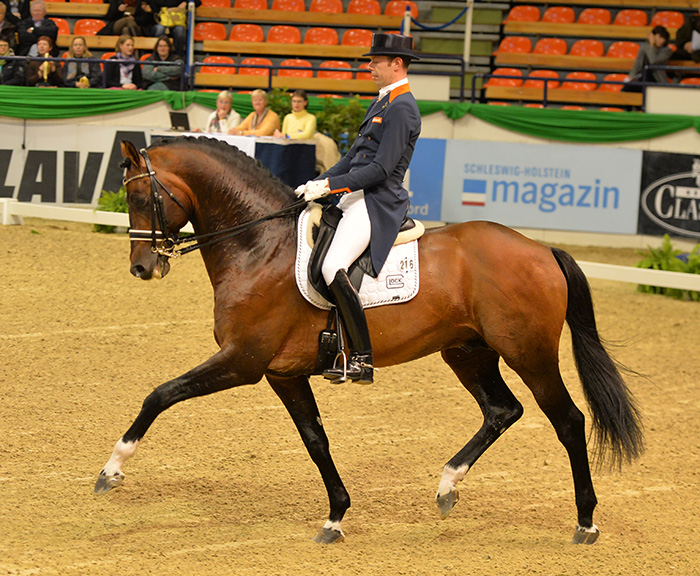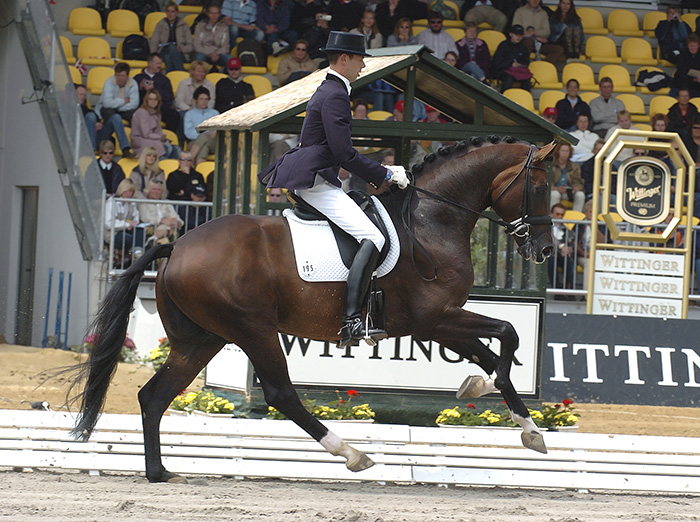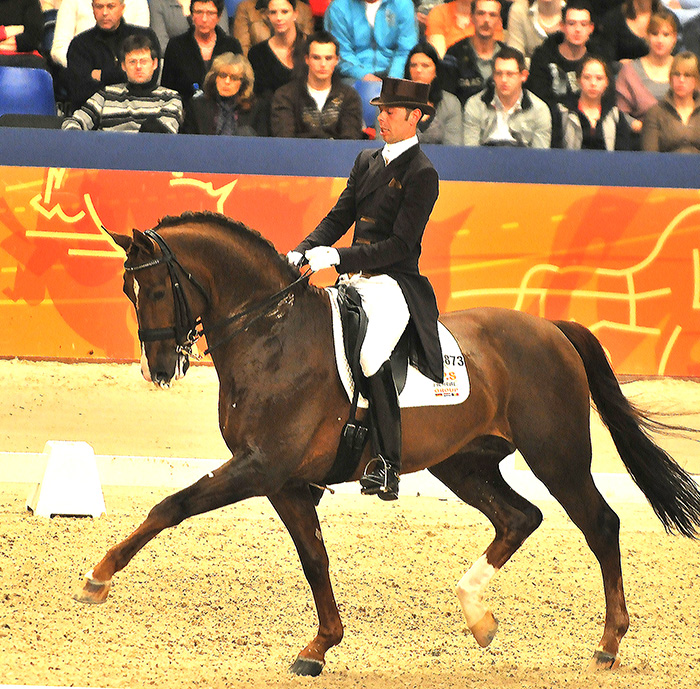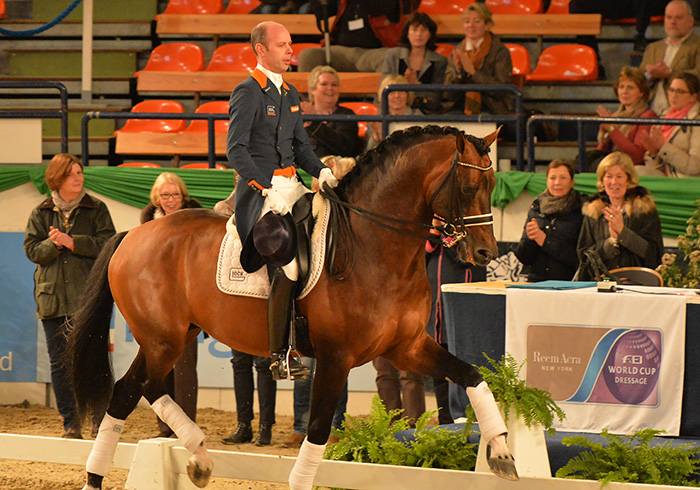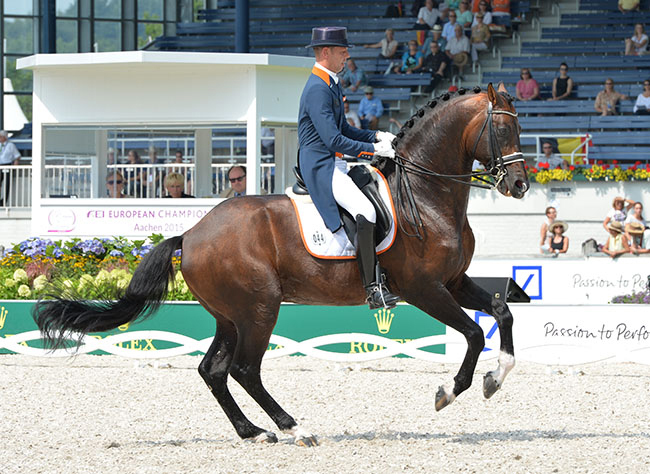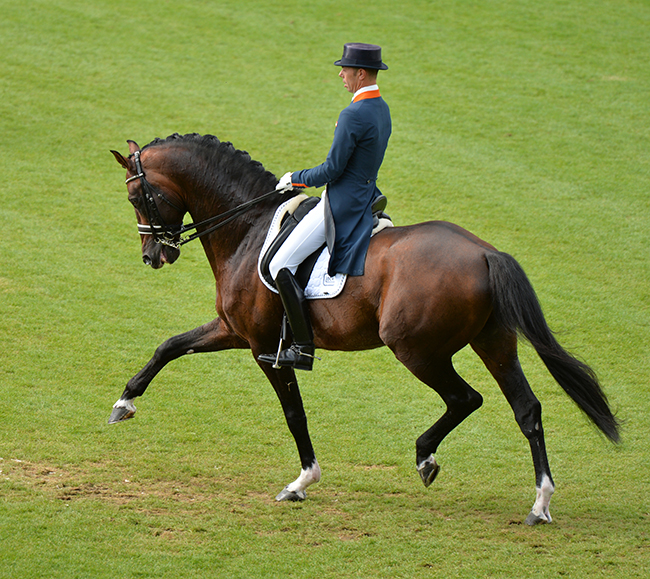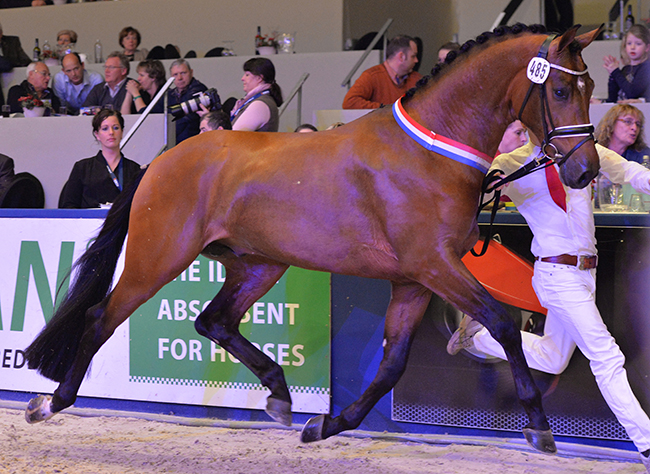2002 1.73 Brown
Breeder: P. van de Vleuten
In September 2020, the Horsetelex Dynamic IPV rankings had at the top of the table one of the new generation of dressage sires – Johnson. The IPV rankings are based on the success of progeny at Prix St Georges level up to and including Grand Prix, divided by the number of offspring – so it represents average performance and corrects the imbalance of sires and studbooks with large numbers of progeny.

Johnson is shaping as perhaps the best son of Jazz, at least so far he has been able to emulate his sire in the competition ring, proving himself a real Grand Prix performer – and followed in the footsteps of his sire to become a member of the Dutch dressage team. Now his worth as a sire is proven with the results on the board, well sort of. He is the only stallion to put two horses into the Horsetelex ISV rankings – based on international competiton – but neither of them are in the star category.
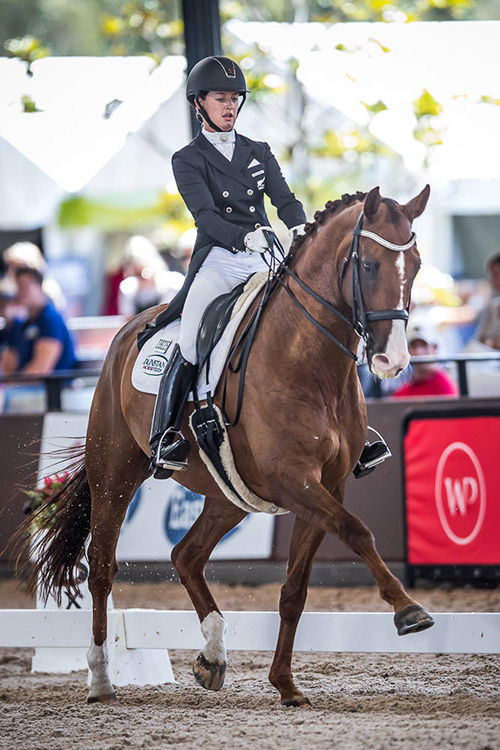
Johnson’s number one – J’Obei W
Meggles Boston (TCN Partout) is 20th on the standings while Johnson’s most successful competitor in 19th, is the Kiwi bred Windermere J’Obei W (out of the Thoroughbred mare Miss Pompeii), a successful Grand Prix competitor and New Zealand Horse of the Year with Melissa Galloway, and has just had a successful Aachen 2022 with Melissa.
Melissa says that J’Obei was very hot but not so difficult as his other brother, Windermere Johanson W (out of another Thoroughbred mare, by Kilimanjaro) who she purchased at the same time: “He’s two years older than Joey and probably not as talented but he’s really consolidated at Grand Prix now. He was particularly difficult. He was the first horse in Australasia by Johnson. He didn’t get a very good reputation because he bucked and had to go to three breakers. He bucked me off six times in the first six months. He was very difficult.”
Johnson does have something of a reputation. One of Holland’s very top dressage stables has a policy of No Johnson, not even horses out of Johnson mares, because they have had such bad experiences with the bloodline – and we are talking here about a couple of the best, most experienced, trainers in the world.
Johnson’s dam Roxane is the usual Dutch mix of Holsteiner, through her sire, Flemmingh, and Selle Français on the dam line – grand dam, Catharin is by Sultan by the Selle Français grand son of Ulimate xx, Marinier, out of a mare by the Holsteiner, Joost, with more Selle Français on the mare line through Artilleur, a grand son of Furioso xx.
Geoff Billington and It’s Otto representing the UK at the 2000 Games
Sultan is the sire of the Oldenburger approved stallion, Sion, and also Geoff Billington’s international jumper, It’s Otto. Johnson descends from the famous ‘Reina’ line; the renowned mare line from breeder Wim van Arkel. Famous horses from this motherline are: Darkdream, Sultan, Kallisto, Mendel, Charmeur and Waldo.
From Johnson’s first breeding year, three offspring were selected to participate in the finals of the world young dressage horse championships at Verden, including Bretton Woods and Boston.
Johnson himself is very successful in international dressage competitions with Hans Peter Minderhoud. The pair were 9th individually at the Olympic Games in Rio, 11th at the WEG in Caen, 8th in the 2014 World Cup final in Lyon, and 3rd in the European Championships in Aachen in 2015.
story continues below the advertisement
Looking for these lines in Australia? Go to www.ihb.com.au
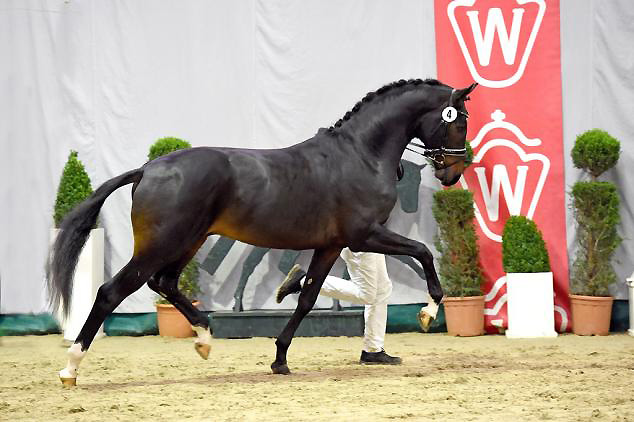
for stallions like Birmingham
It was interesting chatting with Hans Peter Minderhoud at Neumünster. I’d just come from the KWPN licensing where there had been a lot of discussion about the sons of Jazz and the failure of so many of them to go on to Grand Prix – and Hans Peter was the rider for most of them…
Hans Peter Minderhoud and Florencio at the World Young Horse Championships
Tango, a Grand Prix competitor
You have ridden a lot of the sons of Jazz but a lot of them never made it as Grand Prix horses – Tango did but he was a bit unreliable, while Vivaldi never made it past Prix St Georges…
“Tango does a few a good tests, then there are a few not so good – he is actually better in Grand Prix than when he was a young horse, because then he was always very spooky and for his basic gaits he didn’t get super high scores. Now in the Grand Prix test he can do straight changes and nice pirouettes, he still gets his marks. With Florencio and Vivaldi, it is a little bit the same story, the horses were successful as young horses, they have been breeding like crazy every year, frozen semen in the winter, fresh semen in the summer, and with some you just have to make a decision, if the value is higher as a breeding stallion, then keep just him as a stallion because I cannot do both with him. Jazz was actually a little bit the same story.”
“With Johnson it is a bit different because he always stays super good in his mind, and strong in the body. As a young horse we didn’t do so much with him in the summer periods, now he is coming twelve so he had enough time to learn everything, and with him, even when he does both things, he stays good in the body and the mind, so he can combine it. There are not many stallions that can do that, especially when they are so successful as young horses and so busy as a young horse – it is very hard to bring them right up while they are doing both jobs.”
story continues below the advertisement
Will Johnson go on and be a strong horse in international competition?
“Over the last two years in the beginning we always backed off on the training in the breeding season, but now he is breeding in the morning and I ride him a little bit later – maybe at the end of the summer season, then maybe you can feel it, but not so much with him. He is a clever horse, with the breeding he is never stupid, he goes to the phantom, jumps on, does his thing, that’s it. With Florencio, it was up and down and up and down, screaming and kicking and yelling all day.”
It is interesting that there hasn’t been one son of Jazz to come along and say ‘hello, I’m the next Jazz’…
“I think when Jazz was in his time, he was really special and really different to all the other horses, and he really put his mark on all his offspring. Now in Holland we have quite a few stallions – Vivaldi, Apache, Johnson, Charmeur – we have some more stallions and it seems like there is no new Jazz, but that was because in his time Jazz stood out on his own, now there are more top stallions.”
Would you see Johnson as the best Jazz?
“I think so, if you see the offspring, I think so. He has a lot of presence, you really feel it when you come in, even the judges look up – with his nice head, and his big neck, and his front legs, and he is super nice to ride, he is really a sweet stallion.”
The KWPN progeny report summary notes: A uniform collection of well-developed riding-type foals with good rectangular-shaped conformation and which are appreciated in motion. The foals use their legs well and show abundant elasticity as well as good self-carriage.
Breeding recommendation 2006: Johnson can contribute long-lined, uphill conformation, and desired front leg use to dressage horse breeding. He is best bred to mares with good hind leg movement.
Johnson was Hans-Peter Minderhoud’s ride at the 2014 WEG, where they were members of the bronze medal winning team.
Johnson at the Euros
At the European Championships in Aachen in 2015, the pair were again stars. At the 2015 KWPN licensing, Johnson was the sire of the dressage champion, Handsome…
The licensing winner Handsome…
On the 2020 KWPN Breeding Values, Johnson has a dressage breeding value of 159 which puts him into 6th spot on the rankings for stallions with a reliability of 90 and better. Jazz still tops this group with a value of 186, followed by another Jazz son, Olivi on 179, third, Painted Black, 176, fourth, Vivaldi, 166; fifth, another Jazz, Wynton on 160. On the 2021 KIWPN values, Johnson has moved up to 4th with a value of 160, behind, Vivaldi, Painted Black, and the perennial number one, Jazz.




